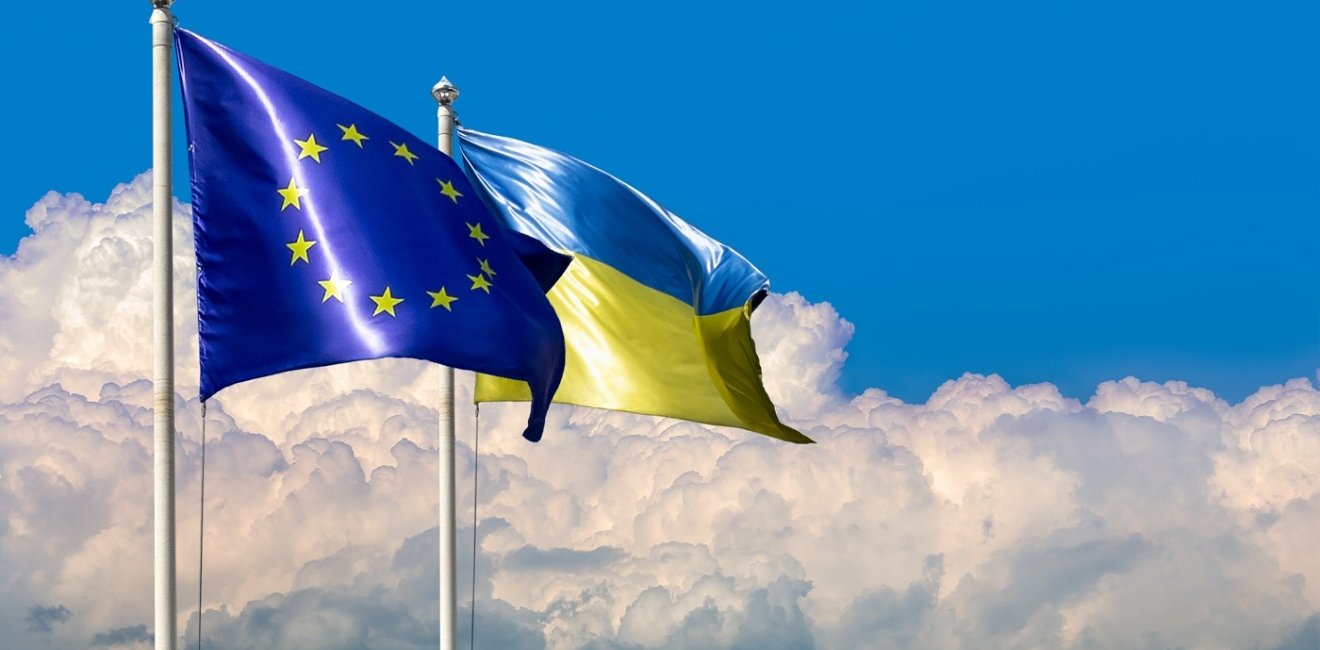
A blog of the Kennan Institute
BY MYKHAILO MINAKOV
The first bomb that fell on Kyiv on February 24 buried the united Europe project that had been born out of the ruins of World War II. This explosion raises fundamental, perhaps even existential, questions, to which Europe is only now starting to wake up.
Over the centuries, artists have portrayed Europe with different faces: doomed and panicked, as that of the mythical victim in Francisco Goya’s The Rape of Europe; arrogant and imperious, as that of Queen Victoria presenting the Bible to the “natives” in T. Jones Barker’s 1861 painting; and heroic and rebellious, as that of Liberty leading the people in the eponymous painting by Eugène Delacroix.
Our era has its own symbolic visages of Europe—like the naïvely optimistic yet wise faces of the three Belarusian Euro-optimists Maria Kolesnikova, Svetlana Tikhanouskaya, and Veronika Tsepkalo, fighting for their people’s right for peace, freedom, and cooperation.
One can argue about the meaning of these faces. But it is undoubtedly the last one—and all of Europe’s moral, ideological, and institutional energy that shines through it—that has inspired the political creativity of people in both the western and eastern parts of the continent since the end of World War II. The qualities it represents are also ones that are most poignantly at stake in the current war in Ukraine.
Following World War II, a group of Western European nations succeeded in building the cultural and economic foundations of a post-national free and peaceful political and legal space. A half-century later, as the Cold War ended and the iron curtain fell, this foundation helped expand the community of nations united by shared legal norms and values including solidarity, governed by the pan-European Council of Europe. This project’s universal values engaged peoples, communities, and individuals, from Dublin to Vladivostok, and offered, for the first time in history, a practical plan for lasting peace and prosperity for all.
Even more politically inspired was the project of the European Union, the political and economic unification which arose out of the collapse of the Eastern Bloc. National and local governments learned to cooperate across borders, through the mechanisms of a common parliament and central bank. Equality and mutually beneficial cooperation were no longer just the philosophical ideals of the Enlightenment but a working model of co-existence.
Together, the Council of Europe and the EU demonstrated that universal ideals can be translated into functional institutions. They proved that a lasting peace is possible—and not only in a graveyard. That the equality of citizen and government is not simply a constitutional aspiration. That international solidarity is not the raving of utopians. That the energy of a free Europe can bridge the gap between theory and practice.
But with time, that energy began to run out.
No matter how solid the EU’s legal and institutional framework, realpolitik began to take its toll. As geopolitical and geoeconomic competition preoccupied Brussels, Strasbourg, and the national capitals of the Council of Europe and EU member states, less energy was left for issues of shared democracy, the rule of law, and human rights.
The language of Europe’s institutions changed accordingly. Instead of clearly articulating a solidarity-based stance, Europe was now expressing “deep concerns.” As economic concerns gained more weight, political, legal, and moral aspects of the European project took a step back. The energies of oil and gas replaced the energy of ideals. Throughout the 2010s, the moral component of the European project became exhausted.
The fundamentalism of the particularists—of sovereigntists, neo-imperialists, and ethnonationalists—increasingly claimed the place of universal foundations, penetrating European and national institutions and eroding the moral and ideological unity of the continent. In the east, Eurasianism was maturing, Putinism was intensifying, and Orbánism and similar ideologies were taking root. In the west, Brexit took an important member of the EU out of the community of shared destiny. And at the heart of Europe differences in understanding the future of the continental project led to discussions of “different speeds” of development and integration—in other words, different destinies.
At the same time, hunger and wars in Asia and Africa forced thousands of people to seek safety in Europe. This migratory wave exposed a tremendous lack of solidarity, both within Europe and outside of it. That crisis threatened to radically undermine the foundation of the European project—universalism. Since then, countries have been building walls between themselves, as though constructing so many derivations of the Berlin Wall. Greeting terrified migrants were barbed wire, border guards’ batons, and European bureaucracy armed with a law criminalizing the rescue of migrants drowning at sea.
Then came 2014, and with it the Russian invasion of Ukraine in Donbas and Crimea. Europe did not view this is a shared catastrophe. Instead, Europe was once again evincing distracted looks and ever-deepening “concerns.” Neither the “Eastern neighborhood” nor the EU-Ukraine Association Agreement led to an EU-wide support for the restoration of peace, the deoccupation of southeastern Ukraine, or punishment of the aggressor. It was the strongest sign yet that the European project was losing its energy and ability to engage all European peoples in a vision of common, peaceful future.
This year, we see the energy of a united Europe depleted. Ludwig Van Beethoven’s “Ode to Joy”—Europe’s anthem—has acquired minor tones. The circle of stars against the blue backdrop on the EU flag looks more and more like a crown of thorns. Brussels is thought of more frequently as the capital of NATO rather than the EU.
Whether or not Europe 2.0 will be built depends on whether Europeans, from east and west, can unite around Ukraine and launch a new era of peace and cooperation from the banks of the Dnieper. The Russian missiles exploding in Ukrainian cities must infuse Europe with new vital energy.
There are signs of hope. Europeans, east and west—ordinary people and un-ordinary politicians—opened their borders to millions of Ukrainian refugees in the first days of the war. The sanctions against Russia that European nations voluntarily adopted show that today’s Europe can still place values above prices. The Ramstein Air Base allies are helping to militarily fortify the Ukrainian resistance.
But the question remains: will Europe as a whole unite—politically and institutionally—around Ukraine? Will it view the disaster that has visited Ukraine as part and parcel of shared European destiny and concern? Will a common front against Putinism become a source of energy for a Big Europe 2.0 project?
The answers to these questions depend on the choices Europe makes today. The forces of exhaustion are powerful. But solidarity, the sense of a shared destiny, and a path toward the next stage of the united European project are still within reach.
This text is reprinted with the permission of the curators of the Ukrainian pavilion at the Venice Biennale 2022. It has been edited for clarity.
The opinions expressed in this article are those solely of the author and do not reflect the views of the Kennan Institute.
Author


Kennan Institute
After more than 50 years as a vital part of the Wilson Center legacy, the Kennan Institute has become an independent think tank. You can find the current website for the Kennan Institute at kennaninstitute.org. Please look for future announcements about partnership activities between the Wilson Center and the Kennan Institute at Wilson Center Press Room. The Kennan Institute is the premier US center for advanced research on Eurasia and the oldest and largest regional program at the Woodrow Wilson International Center for Scholars. The Kennan Institute is committed to improving American understanding of Russia, Ukraine, Central Asia, the South Caucasus, and the surrounding region through research and exchange. Read more

Explore More in Focus Ukraine
Browse Focus Ukraine
Talking to the Dead to Heal the Living

Ukrainian Issue in Polish Elections


